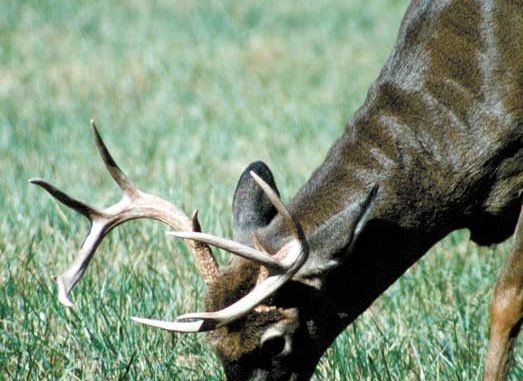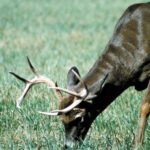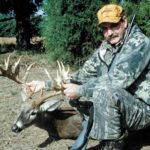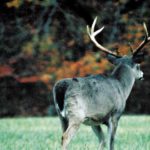
Even after 2007’s record harvest, Tar Heel hunters can look forward to a great year.
During 2005 and 2006, deer hunters produced record-setting harvests in North Carolina.In similar circumstances with most game animals or fish, that’d mean a reduction in the total take the next year because of less animals (or fish) available. Accordingly, most hunters expected a lower number of whitetails for venison steaks and wall mounts last season.
But a funny thing happened on the way to the anticipated harvest drop — Tar Heel hunters not only broke the record for the third straight year, they smashed it to bits, recording 171,986 deer kills. That number was 10.3 percent more than 2006’s previous record of 154,273 deer — and doesn’t include motor-vehicle-caused deer losses (an estimated 15,000 animals), mortality by disease, predation and unreported kills.
Evin Stanford, the N.C. Wildlife Resources Commission’s big-game project leader, isn’t predicting similar results for the 2008 deer season. But he isn’t ruling out another big whitetail harvest — and he won’t be displeased if it occurs.
“We didn’t anticipate the (deer) harvest to increase that much (last year),” he said. “But actually, our objective was to reduce the doe population.”
Why did the WRC want hunters to kill more female deer and how did the agency expect to accomplish that goal?
“We had population models that showed the (deer) herd was relatively stable up until about three or four years ago,” he said. “Then we started hearing a lot of complaints constantly from the legislature, non-hunters and agricultural folks talking about the need for lower deer densities.”
Crop losses and human fatalities after crashing into deer in trucks and cars prompted the requests, in most instances.
In the past, surveys by the WRC showed less than 4 percent of hunters take three or more does each year.
“Everybody in the state could have taken three does per season in the past — but they didn’t,” Stanford said.
Bonus-tag boost
As a result, the WRC instituted a bonus antler-less deer tag program last season. Hunters could ask wildlife cooperator agents (license sellers) for bonus tags. Previously, depending upon the region of the state, hunters could take with a regular hunting license only four does per season (piedmont, northwest, far west) or two does (east).
“Bonus tags could be used at private land in counties that had the maximum either-sex season, about 70 percent of the state, except they couldn’t be used at (state) game lands,” Stanford said.
The tags were free (but that may change) and hunters grabbed them like brass rings on a carousel.
“We gave out 28,000,” Stanford said.
The WRC currently is working on studies to determine how many whitetail does were killed by hunters with bonus tags last season. In the absence of that information, it’s interesting to note 17,713 more deer were tagged in 2007 than 2006 — and 16,772 of them were does.
Even if the bonus-tags-to-extra-doe-kill numbers can’t be figured exactly, Stanford said he has little doubt bonus tags were responsible for the big jump in 2007’s deer harvest.
“The buck harvest actually dropped 2 percent, and that’s what we’ve been looking for,” he said.
But Stanford said bonus antlerless tags also may have encouraged hunters to make more big-game kill reports. Hunters previously report big-game harvests by two methods — telephone or on-line — instead of checking deer at a license agent’s store.
“People weren’t hindered by having only a certain number of deer tags (six) on their license,” he said. “Maybe in the past, especially in two-buck areas, they were reluctant to report a kill, especially if they didn’t have many (either-sex) tags left. Last year they didn’t have that problem.”
Stanford said the WRC wanted hunters to take more does in order to control the deer population.
Why take more does?
“Does are what drive deer populations,” he said. “So you have to target does because they’re dropping (multiple) fawns each spring. Buck harvests don’t have a thing to do with population control because one buck can breed with multiple does.”
Another benefit of taking more does, coupled with a moderate buck harvest, is it moves the whitetail population closer to the ideal 1-to-1 ratio.
“You also create a more defined rut (mating season) by taking more does than bucks,” Stanford said. “If you don’t harvest more does, it also means you’ve got more mouths to feed. If you shoot more does, there’s more resources to go around (for remaining deer), and it improves the overall condition of deer on the landscape.”
Fewer whitetails also mean a less likelihood of debilitating or fatal diseases, such as epizootic hemorrhagic disease, spreading through a deer herd and causing multiple die-offs.
“One mistake (hunters) make is to wait until late in the season to take does instead of taking them early,” Stanford said.
Reasons to take does early in the season include: (a) unharvested does rob nutrition from bucks and the rest of the herd the entire season, especially at food plots and (b) bucks waste valuable energy chasing and breeding does, only to see those females killed afterward. In other words, bucks will have done their job (impregnating does), but hunters negate that work by killing does carrying unborn fawns in December.
“It also evens up the sex ratio before the rut occurs, which makes for a more intense rut,” Stanford said.
Overflowing with deer
Interestingly, 2007’s increased harvest of bucks and does mostly occurred at counties that traditionally have led the state in total harvests.
Although N.C. deer-kill leader Halifax County (5833 tagged deer in 2007) only saw 178 extra kills compared to 2006, No. 2 Northampton County saw a jump of 454 (5317 total in 2007). Bertie County, which like Halifax an Northampton lies inside the Roanoke River corridor, ranked third in 2007 deer kills with 4938, a one-year jump of 607.
Traditionally strong deer counties Wilkes (northwest N.C.) had 4580 deer tagged last season (an increase of 291), while Pender (southeastern N.C.) had 3903, a boost of 399 used deer-kill tags. Anson County (south-central N.C.) rated sixth with 3743 and had a bump of 244.
The county with the largest percentage increase in 2007 deer kills was Chatham, in the north-central piedmont, with 3192 tagged deer, a jump of 685 more than 2006 and a 27-percent increase in one year. And 573 of those kills were does.
That pattern held up across the state.
The doe harvest jumped 21.7 percent from 2006. Two years ago hunters tagged 60,662 does while in 2007 that number increased to 77,434 — the largest one-year harvest increase in WRC records.
White-tailed deer have overspread North Carolina, existing and thriving in every county. The only two counties with relatively small annual harvests are Dare (at the east coast) and Swain (in the far-west corner).
Quality improves
Interestingly, the quality of white-tail bucks continues to improve, as evidenced by the entries at the 2008 Dixie Deer Classic in Raleigh.
Although only one buck scored high enough to be included in the Boone-and-Crockett record book (Chris Lyerly’s 170-point Anson County muzzle-loader trophy), hunters brought many bucks with racks in the 150- to 160-inches range.
The two-buck limit in the piedmont, northwest and west also proved to be a factor in higher-scoring racks.
“Most of the quality deer are coming from two-buck areas,” Stanford said, “because those areas have high-quality habitat.”
Only Jason Burgess’ 136 1/8-inch bow-killed typical, taken in Northampton County, broke the stranglehold of category winners from the piedmont and west.
The top-scoring N.C. buck at last year’s Classic was Wynn Conrad’s 173 3/8inch non-typical taken in Davidson County. Eric Canter’s impressive, wide-racked 5×5 Caswell typical just missed the B&C mark, scoring 166 6/8 inches.
“We’re hearing lots of folks are participating in quality deer management in the piedmont and western part of the state,” Stanford said. “They’re seeing more bucks, the buck harvest is down, and the two-buck limit has put a lot of people in the quality-deer mindset — they’re trying at least to change their hunting behavior, which also contributes to overall buck quality.
“Basically, hunters are being more selective (in what they shoot, bypassing small bucks).”
N.C.’s top buck areas
The notion of a two-buck limit producing quality deer held up as seven of 10 counties with the top bucks-per-square mile ratio were in the piedmont or west. However, three eastern counties (Northampton, Halifax and Franklin) broke into the top 10 for the first time.
Alleghany County, in the northwest corner, led the state with a whopping 7.92 bucks per square mile in 2007. Vance County was second at 6.19 followed by Northampton at 5.93 and Wake, 4.70, in fifth place.
Although every county and many city suburbs have whitetails now, not everyone has private land they can hunt — although the large deer herd is giving private landowners more incentives to allow hunting. That means public game lands receive lot of visits by deer hunters.
Best game-land bets
As expected last year, the game lands near three large population areas (Raleigh, Durham and Chapel Hill, aka the Triangle), led the state in deer harvests.
Chatham County game-land hunters notched 405 deer tags while Wake County hunters downed 387 game-land deer. The popular Jordan Lake game land, surrounding the lake of the same name, is in Chatham while parts of the Falls of the Neuse, Jordan and Shearon Harris game lands are in Wake County.
Montgomery County (a few miles east of Charlotte) rated third with 331 tagged deer taken from its sprawling Uwharrie Game Land while Pender County (just north of Wilmington) was fourth with 274 tags from its three game lands (Angola Bay, Cape Fear Wetlands and massive Holly Shelter). Bertie County (Roanoke River Wetlands and National Wildlife Refuge) was fifth with 223 deer and Caswell County was sixth at 221 taken at the Caswell GL Duplin County was only one behind Caswell with 220 deer downed at a tiny section of the Angola Bay GL in the county’s southern tip. A newcomer to the top 10, Craven County, rated eighth in game-land harvests last season, with 175 tags filled at the Neuse River GL. Halifax County, with 163 deer shot at the Roanoke River Game Lands, was ninth, while Hyde County’s Gull Rock, Pungo River and New Lake game lands ranked 10th with 162 harvested whitetails.







Be the first to comment